
The sea that covers most of the surface of planet Earth is called the ocean.
Ocean is the sea of immense dimensions that covers most of the earth's surface (according to experts, 71% ). Each of the subdivisions of this sea ( Atlantic , Pacific , Indian , etc.) is also known as an ocean. Within these segmentations, the largest ocean is the Pacific .
It is important to highlight the existence of what is known as oceanography . This is the area of Earth sciences whose clear mission is to study the entire set of processes (chemical, biological, geological...) that take place both in the aforementioned oceans and in the seas in general.
ocean study
Starting from the aforementioned processes, it must be stated that this area, also called marine sciences , can be divided into four clearly differentiated branches. Thus, there is chemical oceanography , which is responsible for studying and analyzing in depth the chemical composition of sea water.
Secondly, we find biological oceanography , which carries out the study of the entire set of marine beings and organisms. But not only that, it also does the same thing about the relationship between all of them and the environment in which they find themselves.
The third branch of oceanography is called geology . In this case, its mission is to undertake the exhaustive analysis of all the geological processes that affect the oceans. Thus, in this way, it focuses especially on the sedimentation or morphology of bodies that are on the coast such as beaches or estuaries.
Finally, in fourth place is physical oceanography , which is responsible for studying, for example, everything from tides to waves and currents. In turn, it is divided into three areas: meteorological, dynamic and descriptive.

Ocean navigation allows the transportation of goods worldwide.
Its characteristics
Geographic and geological scholars maintain that the ocean emerged around 4 billion years ago, at a time in history when the Earth 's surface cooled to such an extent that it caused water to become liquid. Its depth depends on each area analyzed, although it must be said that the average depth is around four kilometers . The deepest part of the ocean is 11,033 meters , a mark found in the Mariana Trench .
The surface layer of the ocean has a temperature that ranges between 12º and 30º . Below, a layer of colder water is usually detected, between 5º and -1º . The boundary between both layers is known as the thermocline .
Ocean water is salty . About 3.5% of the volume of water is made up of materials in solution; When evaporation is high, a large amount of water disappears and only dissolved substances are kept there, increasing salinity.
On the other hand, in the polar regions the salinity is lower, especially during the summer season, as the ice is diluted in the ocean water.
In general, the water of the ocean never remains in a state of stillness, but moves as a result of the formation of waves that are born by the wind blowing on the surface. These waves, which can be of different heights, play an important role in shaping coastlines.
